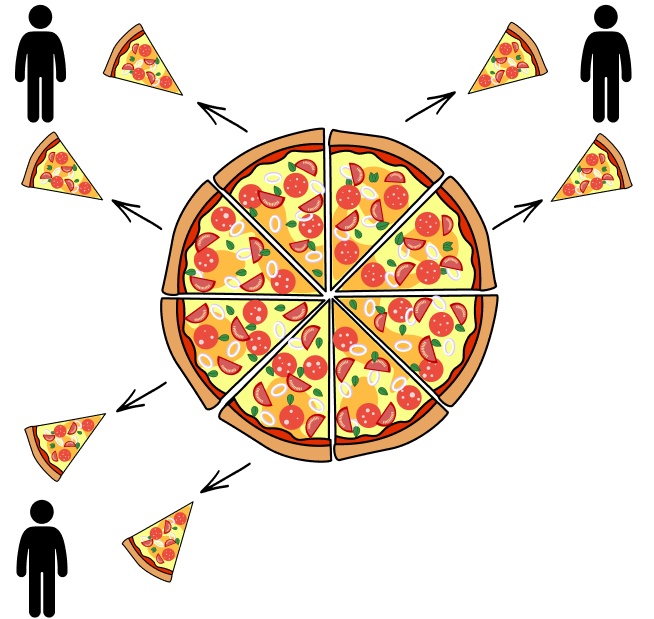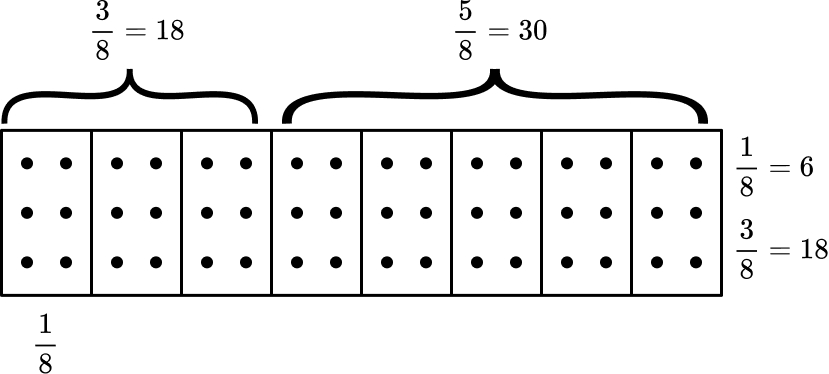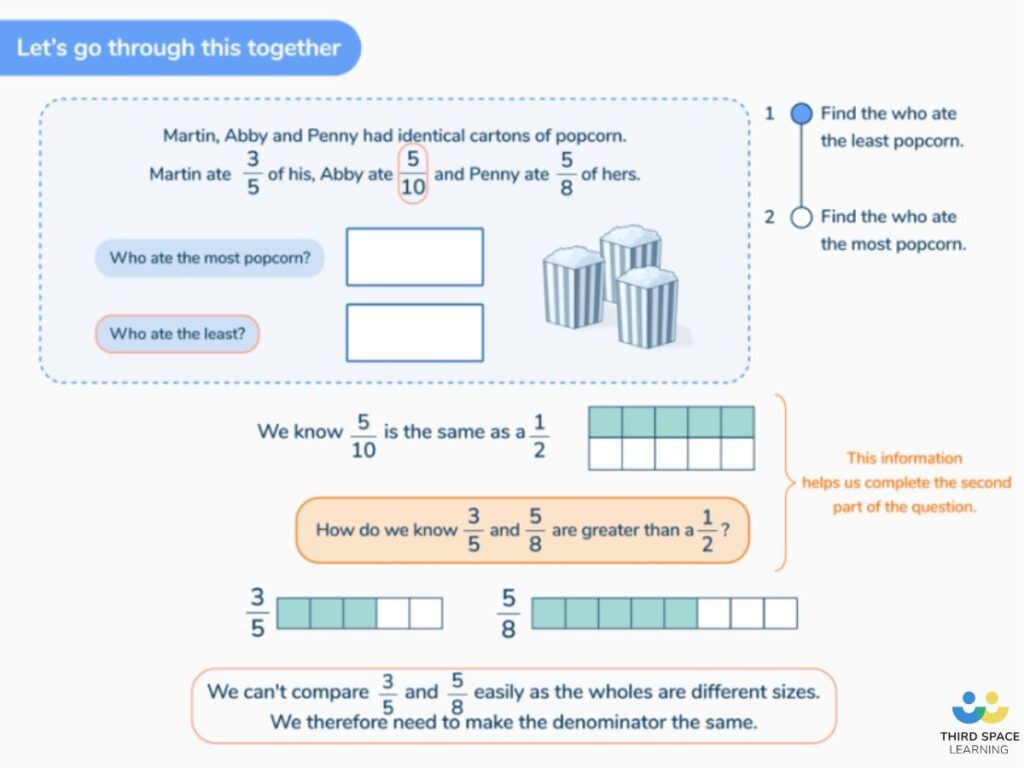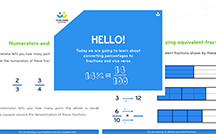28 Fraction Word Problems for Year 2 to Year 6 With Tips On Supporting Pupils’ Progress
Fraction word problems are an important piece in teaching fractions. Fractions are a key component of the National Curriculum throughout primary, with children introduced to the concept in Year 1 and continuously building upon their knowledge and understanding, through to Year 6 and beyond.
The abstract nature of fractions makes them one of the more difficult areas of maths for children to understand. It is essential that they are taught through the use of concrete resources and visual images, but also through a link to the real world. Word problems are a great way to help children develop this understanding and should be used alongside any fluency work the children do.
To help you with this, we have put together a collection of 20 word problems which can be used with children from Year 2 to Year 6.
- Fraction word problems in the national curriculum
- Why are word problems important for children’s understanding of fractions?
- How to teach fraction word problem solving in primary school
- Fraction word problems for primary
- Fraction word problems for Year 2
- Fraction word problems for Year 3
- Fraction word problems for Year 4
- Fraction word problems for Year 5
- Fraction word problems for Year 6
- More word problems resources
Fraction Lessons Resource Pack
Download this free pack of fraction lessons to support your students and help them to practice fractions problems.
Download Free Now!Fraction word problems in the national curriculum
Fractions in KS1
Pupils are first introduced to fractions in Year 1, where they begin to recognise a half and quarter of a shape or quantity. As they progress through Key Stage 1, they are introduced to a wider range of fractions.
In Year 2 pupils need to be able to recognise, find, name and write fractions \frac{1}{3}, \ \frac{1}{4}, \ \frac{2}{4} and \frac{3}{4} of lengths, shape, a set of objects or quantity.
Fractions in lower KS2
Once pupils move into Key Stage 2, there is an increased focus on fractions, with a significant period of time dedicated to developing students’ knowledge and building on previous learning from Year 3 through to Year 6.
In Year 3, pupils are taught to count in tenths; recognise, find and write fractions of a discrete set of objects; understand the term ‘unit’ and ‘non-unit’ fractions; recognise equivalent fractions, compare and order fractions and add/subtract fractions with the same denominator. At this stage, pupils also begin to solve simple problems involving fractions.
As pupils progress into Year 4, they are also introduced to the concept of decimals alongside the work on fractions. They build upon their understanding of equivalent fractions and adding/subtracting fractions (still with the same denominator.
They also learn to count up and down in hundredths, recognise and write decimals equivalent to \frac{1}{4}, \ \frac{1}{2} and \frac{3}{4} and begin to solve problems with increasingly harder fractions.
Fractions in upper KS2
As pupils continue through the school, into upper Key Stage 2, they continue to build on their learning. They are introduced to mixed numbers and improper fractions. They are also introduced to the concept of percentages alongside fractions and decimals.
In Year 5, children build on the knowledge gained in Year 4, comparing and ordering fractions; recognising equivalent fractions; addition and subtraction of fractions (with different denominators, but multiples of the same number). Fractions appear in addition and subtraction word problems.
They are also introduced to the multiplication of fractions; converting between improper fractions and mixed numbers and the link between fractions, decimals and percentages. By Year 5 pupils will be completing more complex problems, including multi-step word problems and multiplication word problems.
In Year 6, pupils consolidate and build upon the knowledge of fractions they have gained so far. Pupils continue to add and subtract fractions (with different denominators and mixed numbers). They also develop their understanding of how to multiply fractions and begin to divide fractions by whole numbers, combining fraction and division word problems.
Pupils also continue to build upon their understanding of the equivalences between fractions, decimals and percentages and solve increasingly complex one-step, two-step and multi-step percentage word problems.
Why are word problems important for children’s understanding of fractions?
Word problems, alongside the use of concrete resources and visual images, help children to make sense of the abstract nature of fractions.
For example, if children were presented with the question \frac{6}{8} ÷ 3, some might find this difficult to access. If children are given it as a word problem, alongside a visual image, it becomes much more accessible.
The above calculation as a word problem:
‘3 children shared \ \it{\frac{6}{8}} of a pizza, how much did each child get?’

Children can see and understand the concept of 3 children sharing 6 slices of pizza, compared to just seeing the written calculation.
How to teach fraction word problem solving in primary school
As with all word problems, the first thing children need to do is read the question carefully and make sure they understand what is being asked. They then have to decide what calculation is needed and whether they can represent it pictorially.
Here is an example:
Ben has a bag of 48 sweets.
He gives \frac{3}{8} of his bag to his brother
How many sweets does he have left?
How to solve:
What do you already know?
- There are 48 sweets altogether.
- The denominator is 8, so we know we need to divide the 48 by 8. This will tell us how many sweets in \frac{1}{8} .
- The numerator is 3, therefore we need to multiply the answer by 3, to tell us how many sweets are \frac{3}{8} .
- The last step of the problem is to find out how many sweets Ben has left.
- We can either calculate \frac{5}{8} , as we know Ben must have \frac{5}{8} left, or we subtract the number of sweets in \frac{3}{8} from the total of 48.
How can this be drawn/represented pictorially?

- We can draw a bar model, split into 8 sections.
- The 48 sweets are then shared between the 8 sections (each worth \frac{1}{8} ).
- We can see that \frac{3}{8} of the 48 sweets equals 18 sweets.
- We can then either subtract 18 from 48, to work out how many sweets were left. 48 – 18 = 30
- Alternatively, we can calculate how many sweets are in \frac{5}{8} , which is 30.
Word problems are tied in throughout Third Space Learning’s online one-to-one tuition programmes. Tutors work with students to break down word problems and identify the operations needed to solve problems.

Fraction word problems for primary
The following section lays out the types of fraction word problems that you can expect to see by year group in primary school.
At Third Space Learning we incorporate word problems into our one-to-one online tutoring. With each lesson designed to suit the needs of each individual student, our tutoring programme aims to deepen mathematical understanding and confidence in maths.
Fraction word problems are a great way to strengthen students’ conceptual understanding of fractions and grow their problem solving skills. Take a look at our article on fraction games to help with this.
Read more:
- What Is A Unit Fraction: Explain For Primary School
- What Is An Improper Fraction: Explained For Primary School
- Fractions: A Comprehensive Guide
- How To Teach Fractions Key Stage 2: Maths Bootcamp
- How To Simplify Fractions: A Comprehensive Guide
Fraction word problems for Year 2
Word problems in Year 2 involve recognising and naming simple fractions and beginning to understand the concept of equivalence.
Question 1
Maisie was having a birthday party.
She invited 16 friends. Half of her friends were from her class and a half were from the other Year 2 class.
How many friends did she invite from each class?
Answer: 8 friends
\frac{1}{2} of 16 = 8
Question 2
Ahmed baked 12 cookies.
He ate \frac{1}{4} of them.
How many cookies did Ahmed eat?
Answer: 3
\frac{1}{4} of 12 = 3
Question 3
Sara says ‘I ate \frac{1}{2} a pizza and my friend ate \frac{2}{4} . My friend had more than me, as she had 2 pieces’.
Is she correct? Explain why you have chosen your answer.
Answer: Sara is not correct
\frac{1}{2} is the same as \frac{2}{4}
Question 4
Tom and Zeyn shared a chocolate bar.
They both had a quarter of the chocolate bar.
How much was left?
Answer: \frac{1}{2} of the chocolate bar
\frac{2}{4} are equivalent to \frac{1}{2}
Fraction word problems for Year 3
Word problems for Year 3 include proper fractions, fractions of amounts, simple equivalent fractions and adding and subtracting fractions with the same denominator.
Question 1
Sophie ate \frac{1}{4} of her chocolate bar.
If the bar had 20 squares, how many squares did Sophie eat?
Answer: 5 squares
\frac{1}{4} of 20 = 20 ÷ 4 = 5
Question 2
Hamza and Khalifa shared a pizza.
Hamza ate two fourths of the pizza and Khalifa ate one fourth.
How much pizza was left?
Answer: \frac{1}{4}
\frac{2}{4}+\frac{1}{4}=\frac{3}{4} 1-\frac{3}{4}=\frac{1}{4}
Question 3
There are 24 hours in a day.
Maise worked out that she spends \frac{1}{8} of her day on Saturday, doing exercise.
How long does she spend exercising on a Saturday?
Answer: 3 hours
\frac{1}{8} of 24 hours = 24 ÷ 8 = 3
Question 4
There are 30 children in the class.
\frac{2}{5} of the children are wearing jumpers.
How many children are wearing jumpers?
Answer: 12 children
\frac{1}{5} of 30 = 30 ÷ 5 = 6
\frac{2}{5} of 20 = 12
Fraction word problems for Year 4
Word problems for year 4 include equivalent fractions, fractions of quantities (including non-unit fractions and adding/subtracting fractions with the same denominator. Money word problems often appear in Year 4.
Question 1
Abdullah spent \frac{1}{3} of his pocket money for the month on a new game.
He receives £18 per month.
How much did he spend on the game?
Answer: £6
\frac{1}{3} of 18 = £6
Question 2
Bethan had a bag of sweets.
She gave \frac{2}{7} of the bag to her mum and ate \frac{3}{7} of herself.
What fraction of the bag was left?
Answer: \frac{2}{7}
\frac{2}{7} + \frac{3}{7} = \frac{5}{7} \frac{7}{7}-\frac{5}{7}=\frac{2}{7}
Question 3
Jamal ate \frac{6}{18} of a chocolate bar.
Mason ate \frac{1}{3}
Mason said that Jamal ate more than him. Do you agree? Explain your answer.
Answer: No – they both ate the same.
\frac{1}{3} is equivalent to \frac{6}{18}
Question 4
\frac{2}{7} of a piece of ribbon is 10cm.
How long is the whole piece of ribbon?
Answer: 35cm
\frac{2}{7} = 10
\frac{1}{7} = 5
\frac{7}{7} = 5 x 7 = 35
Fraction word problems for Year 5
Word problems for Year 5 include more complex equivalent fractions, problems involving mixed numbers and improper fractions, adding and subtracting fractions (with different denominators) and multiplying fractions.
Question 1
There are 60 pupils in Year 5.
Eden carried out a survey on favourite foods.
\frac{1}{5} of the children said pizza, \frac{2}{6} said burgers and \frac{3}{10} said hot dogs.
How many pupils did she survey altogether?
Answer: 50 pupils
\frac{1}{5} of 60 = 12
\frac{2}{6} 0f 60 = 20
\frac{3}{10} = 18
Question 2
The Johnson family are driving to the zoo.
They have driven \frac{5}{9} of their journey, which is 45 miles.
How much further do they have to drive, to reach their holiday home?
Answer: 20 miles left to drive
\frac{5}{9} = 45, therefore \frac{1}{9} = 45 ÷ 9 = 5.
\frac{5}{9} = 5 x 5 = 25 miles
\frac{9}{9} = 9 x 5 = 45 miles
45 – 25 = 20
Question 3
Macy is taking part in the school maths challenge.
She is given a word problems worksheet containing 36 questions.
Macy gets \frac{7}{9} of the questions correct.
How many does she get wrong?
Answer: 8 questions wrong
\frac{1}{9} of 36 = 4
\frac{7}{9} = 28
\frac{2}{9} = 8
Question 4
Oliver and Zac are making smoothies.
They make 800 ml of smoothies.
\frac{2}{5} is made from apples, \frac{3}{7} from strawberries and the rest from orange juice.
How many ml of orange juice do they add to the apples and strawberries?
Answer: 180ml orange juice
\frac{2}{5} of 800: \frac{1}{5} = 160ml, \frac{2}{5} = 320 ml apple juice
\frac{3}{8} of 800: \frac{1}{8} = 100, \frac{3}{8} = 300 ml strawberry juice
800 – 620 = 180ml
Fraction word problems for Year 6
Word problems for year 6 include adding and subtracting fractions with different denominators and mixed numbers, multiplying fractions, dividing fractions by whole numbers and finding equivalent fractions, decimals and percentages.
Question 1
Children in a Year 6 Class at Oak Tree Middle School are answering a set of ratio questions.
There are 10 questions and 28 children completing the activity.
If the children got \frac{6}{7} of the total number of questions correct between them.
How many did they get wrong?
Answer: 40 questions wrong
28 x 10 = 280 questions
\frac{1}{7} of 280 = 40
\frac{6}{7} = 40 x 6 = 240
Question 2
Amber and her 5 friends are sharing 4 pizzas for her birthday party.
The pizzas are split into sixths.
If they each eat the same amount of pizza, how many slices does each person at the party get?
Answer: 4 slices
This is a dividing fractions word problem
\frac{24}{6} ÷ 6 = \frac{4}{6}
Question 3
A group of friends win a quarter of the total lottery prize for the week.
There are 4 friends and each friend shares an equal fraction of the quarter.
What fraction of the total lottery prize does each friend get?
Answer: \frac{1}{16} of the prize fund
Each friend gets \frac{1}{4} of the \frac{1}{4} prize fund
\frac{1}{4} \times \frac{1}{4} = \frac{1}{16}
Question 4
There are 30 children in the class
\frac{7}{10} of the pupils in the class are girls.
\frac{3}{7} of the girls have their ears pierced.
How many girls have their ears pierced?
Answer: 9 girls have their ears pierced
\frac{1}{10} = 3, \ \frac{7}{10} = 21 girls
\frac{1}{7} of 21 = 3. \ \frac{3}{7} = 3 x 3 = 9
More word problems resources
Third Space Learning offers a wide range of practice word problems for all primary year groups and covering a large number of topics, including; time word problems, ratio word problems, fraction questions, addition word problems and subtraction word problems.
DO YOU HAVE STUDENTS WHO NEED MORE SUPPORT IN MATHS?
Every week Third Space Learning’s specialist primary maths tutors support thousands of students across hundreds of schools with weekly online 1 to 1 maths lessons designed to plug gaps and boost progress.
Since 2013 these personalised one to one lessons have helped over 150,000 primary and secondary students become more confident, able mathematicians.
Learn how tutors develop pupils’ maths fluency or request a personalised quote for your school to speak to us about your school’s needs and how we can help.




